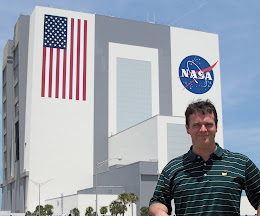 |
| Russian Soyuz lifts off carrying an international crew to space station. (NASA) |
CAPE CANAVERAL, Fla. -- An American, Russian and German astronaut lifted-off into the midnight sky over western Kazakhstan today beginning a six month voyage aboard the International Space Station.
The crew will have one of the busiest work schedules through November as they perform science investigations, welcome several resupply crafts and oversee five spacewalks.
As U.S. and Russian ties remain strained here on earth, aboard the orbiting laboratory 260 miles above, astronauts and cosmonauts continue to work as good friends for several months at a time.
Veteran space station astronaut Dottie Metcalf-Lindenburger commented to this aerospace journalist recently her feelings on America's working relationship with Russia in space.
"The Russians are our friends when we are on orbit," Lindenburger stated. "Our countries make political decisions we don't agree with, but when we are on orbit, we are colleges and we are friends and we work together."
NASA astronaut Reid Wiseman, Russian cosmonaut Maksim V. Surayev and European Space Agency astronaut Alexander Gerst boarded their Soyuz TMA-13M a few hours prior to lift-off.
Strapped in a top a Soyuz FG booster, the international crew of three launched from the Baikonur Cosmodrome at 3:57:40 p.m. EDT on Wednesday, beginning a six hour chase to dock with the orbiting outpost.
As flashes of lightning illuminated the horizon, the rocket's golden flame pushed the Soyuz skyward with 930,000 pounds of thrust as it began an eastward flight.
Nine minutes after launch, the Soyuz craft was safely on orbit in an initial orbit of 143 x 118 miles, and 1,677 statue miles below and behind the space station.
Wednesday's launch is an expedited voyage to the complex in which Russian flight controllers began using last year. A thruster failure in March on the last crew's trip forced controllers to extend the flight to ISS back to the old two day trip plan.
Surayev is scheduled to dock Soyuz to the station's Russian segment known as the Rassvet service module at 9:48 p.m.
The international crew marks the first all-Twitter space crew (
Wiseman and Gerst, who were both selected as astronauts in separate countries in 2009, are each making their first spaceflight.
Baltimore native Gregory Reid Wiseman is a former U.S. Navy test pilot who grew up with an interest in exploration.
From camping at the lake and attending the Navy's Blue Angels airshows as a child, he grew up to become a test pilot for a few of today's latest military aircraft including the F-35.
Wiseman considers his flight to the space station as the ultimate exploration trip.
"We are explorers by our very nature, and right now, the biggest exploration that a human can go on is 250 miles up on the space station," Wiseman said with a sense of excitement in his voice. "Of course it's worth the risk, to go out there and push humanity further than we've ever been that's a no brainer."
German astronaut Gerst spent his pre-astronaut years in a career as a volcanologist, researching volcanoes across the Eastern Hemisphere and designing scientific instruments to help predict their eruptions.
Gerst became a member of Europe's astronaut class of 2009 only after some urging by NASA astronaut Cady Coleman while the pair were trapped by weather at Antarctic McMurdo.
"Being the first wave of explorers on the way out exploring the universe -- the Moon, asteroids, Mars and beyond -- that is for me such an important thing to do for humankind and for science," Gerst noted.
Soyuz commander Surayev logged 169 days in space during his first expedition to the space station in 2009 and 2010.
A Russian fighter pilot with a law degree, Surayev is scheduled to perform his second career spacewalk this October with a fellow cosmonaut.
Wiseman, Surayev and Gerst are due to return back to earth in mid-November.
(Charles Atkeison reports on aerospace, science and technology. Follow his updates via Twitter @AbsolutSpaceGuy.)




